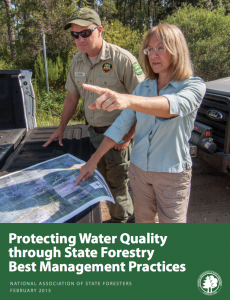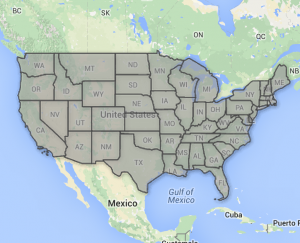The National Association for State Foresters (NASF) recently released a report on forestry best management practices (BMPs) for water quality, accompanied by an interactive map detailing practices in each state.
 State forestry agencies have been developing BMPs since the 1970s, building a reliable set of standards that help protect local water quality when undertaking silvicultural activities.
State forestry agencies have been developing BMPs since the 1970s, building a reliable set of standards that help protect local water quality when undertaking silvicultural activities.
“Best management practices are an effective way of protecting water quality and preventing pollution,” said Jim Karels, Florida State Forester and NASF President. “Much of the nation’s drinking water originates from forests and these measures ensure that those lands continue to provide such an important societal need.”
The research project analyzing data submitted by all 50 states was conducted by a team of researchers from Virginia Polytechnic Institute and State University and commissioned by NASF. The research confirms that state-managed best management practices programs are effective and working as intended to protect water quality.
The research also concludes that increased federal dollars in support of state forestry water resources programs will improve critical monitoring capabilities. State forestry agencies can utilize the research findings to continue to evolve and improve their best management programs by comparing how other states approach this responsibility.
“We need to ensure that best management practices receive the support and monitoring they deserve,” said Paul Tauke, Iowa State Forester and chair of the NASF Forest Resources Management Committee. “At a time when our national water supply is more important and stressed than ever, ensuring our forest industries follow the best practices available will go a long way towards ensuring we have cleaner and more plentiful water for generations to come”.
State forestry agency BMPs cover activities on nearly 500 million acres of state and private forestland. These forests provide a wide range of public benefits, including filtering more than 50 percent of the nation’s drinking water.
 An interactive, state-by-state map has been developed to display the research findings and recommendations from all 50 state forestry agencies for BMP implementation. The map is the most recent, complete and comprehensive map of research studies in this field.
An interactive, state-by-state map has been developed to display the research findings and recommendations from all 50 state forestry agencies for BMP implementation. The map is the most recent, complete and comprehensive map of research studies in this field.
By utilizing the map, located at www.stateforesters.org/state-forestry-BMPs-map, the forest sector can now access the standards and regulations that guide the responsible management of woodlands in each state.
Landowners and forest product manufacturers who participate in forest certification can use the map to address water quality protection requirements in certification standards. Policy makers can gain a comprehensive understanding of how provisions of the federal Clean Water Act are supported by each state forestry agency.
To learn more about Water Quality and Georgia’s Best Management Practices for Forestry, visit the Georgia Forestry Commission’s website here.

